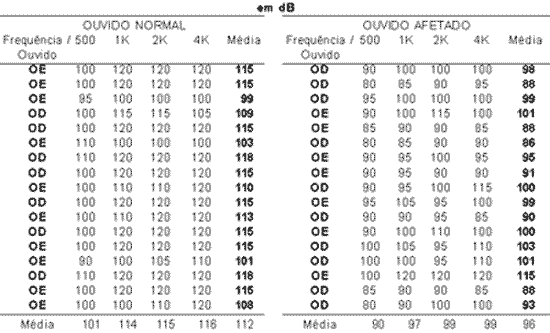INTRODUCTIONBell's palsy is unilateral facial palsy of sudden onset and unknown cause. This pathology is quite frequent in ENT emergency exactly because it has sudden onset and make patients become very anxious and concerned about the progression of the clinical picture and its cause.
It may be preceded by pain in the pinna region or a situation of stress, anxiety and later distress and depression.
The face has no facial expression on the affected site and facial musculature is deviated to the contralateral side. It may affect salivation, taste and lachrymation, depending on the topography of the facial nerve affection. Patients may refer auditory hypersensitivity 1, the symptom which was studied in the present report.
In patients with Bell's palsy, stapedial reflex may be absent. Perlman (1938)2 & Tschiassny (1994)3 reported cases of patients with Bell's palsy who reported hearing loss and they agreed that the cause of hearing loss in these patients could have been the absence of stapedial reflex. The reflex is derived from bilateral contraction of stapedial muscle in the middle ear, in response to loud sounds, which occurs at about 85dB HL.
Hyperacusis is defined as hypersensitivity to common everyday sounds, perceived as unbearable, strong or painful (Schwade, 1985)4, (Sammeth, Preves & Branby, 1997)5.
Marriage & Barnes (1995)6 classified hyperacusis as peripheral or central. Peripheral hyperacusis occurs when stapedial reflex is absent and sound is perceived as louder. Central hyperacusis is specific sound hypersensitivity, not necessarily of loud sounds, resulting from serotonin dysfunction.
Sahley, Nodar & Musick (1997)7 reinforced that suppression and reduction of amplitude of nervous action potential is the best way to document activation of medial efferent fibers.
Efferent pathway could be involved in the explanation of hyperacusis, given that the auditory protection mechanism against loud sounds, for this reason, would be deactivated and sound waves that reached the inner ear would be somewhat amplified towards the brain.
The purpose of the present study was to check whether patients with Bell's palsy had hyperacusis or not.
MATERIAL AND METHODWe examined 18 random patients who presented peripheral Bell's palsy and came to the ambulatory of Facial Palsy, Service of Otorhinolaryngology, Hospital Sao Paulo - Escola Paulista de Medicina.
In order to classify the patients, we followed the criteria below:
1. Exclusion of possible factors that could cause palsy
2. Duration of palsy equal or less than one week
3. Absence of middle ear disorders
4. Patient had not been clinically treated yet
We conducted complete ENT examination, Hilger's test, Schirmer's test, electrogustometry, pure tone audiometry and speech discrimination, immittanciometry, and hearing discomfort thresholds with audiometer Maico MA-41, classifying palsy's grade according to House (1993) and applying the protocol to study research data. All patients were assessed by the same physician and the same audiologist.
All patients were treated with regressive doses of prednisone.
We considered hyperacusis as hypersensitivity to everyday common sounds perceived by patients as unbearable, strong and painful.
RESULTSFindings in the present study evidenced that:
"Age of patients ranged from 18 to 60 years; the most affected age range was 31 to 40 years (Graph 1).
"Female subjects were more affected by peripheral facial palsy, reaching 61% of the cases (Graph 2).
"Right hemiface was affected in 56% of the cases, with no relevance for prognosis (Graph 3)."The most frequent grade of palsy, according to House classification, was grade IV in 44% of the cases and grades III and V in 28% of the cases each.
"Hyperacusis was present in only one patient, which amounted to 5.5% of the cases.
"All patients presented reduction of loudness tolerance thresholds measured by the audiometer, and the stapedial reflex protected them by 16dB on average (Table 1).
DISCUSSIONPeripheral Bell's palsy is one of the most frequent causes and, according to publications, its incidence ranges from 11 to 12.8 new cases per 100,000 inhabitants8.
It may be attributed to a vascular cause, but clinical, experimental and epidemiological arguments suggest that it is polyneuritis caused by herpes virus simplex that affects the facial nerve9.
Clinically, it has sudden onset with progression within few hours with the following signals: facial or pharyngeal pain, retroauricular pain and changes to the taste sensation in the affected hemitongue.
As to hyperacusis complaint, only one patient (5.5%) referred complaint of auditory discomfort, which did not differ from the complaints referred by the general population. Therefore, stapedial muscle palsy did not influence in the onset of these manifestations.
Comparing the hearing discomfort threshold on the paralyzed side in relation to the normal side, we noticed that there was reduction of discomfort thresholds in the paralyzed side. Therefore, there was contradiction between patients' complaint and the audiometric finding. Possibly it was due to the fact that reduction of discomfort level is not enough to cause clinical manifestations of hyperacusis.
CONCLUSIONPatients with Bell's palsy clinically presented complaints of hyperacusis similar to those of the general population, but audiologically, loudness tolerance threshold on the paralyzed side was lower than on the normal side.
REFERENCES1. Northern JL & Gabbard SA. The Acoustic Reflex. In: Katz J. (ed). Handbook of Clinicial Audiology. 4th ed. Baltimore: Willian & Wilkins; 1994.
2. Perlman HB. Hyperacusis. Ann Otol Rhinol Laryngol 1938; 47:947-53.
3. Tschiassny K. Stapedioparalytic Phonophobia ("hyperacusis"). In: A Deaf Ear. Laryngoscope 1949; 59: 886-903.
4. Schwade S. Shedding Light on Supersensive Hearing. Prevention 1995; 96: 91-9.
5. Sammeth CA, Preves DA, Branby WF. Hyperacusis: causes symptoms and treatment. Ft. Lauderdale: Instrutional Short Course at the AAA Convention; 1997. 4p.
6. Marriage J & Barnes NM. Is Central Hyperacusis a Symptom of 5-hydroxytryptamine (5-HT) Dysfunction. J Laryngol Otol 1995; 109:(10) 915-21.
7. Sahley TL, Nodar RH, Musiek FE. Clinical Relevance. In: Efferent Auditory System. San Diego: Singular Publishing Group; 1997. p. 7-24
8. Adour K. Medical Management of Idiopathic (Bell's) Palsy. Otolaryngol Clin North Am 1991; 24: 663-73.
9. Yanaquinara N. Incidence of Bell's palsy. Ann otol Rhinol Laryngol Suppl 1988; 137: 3-4.
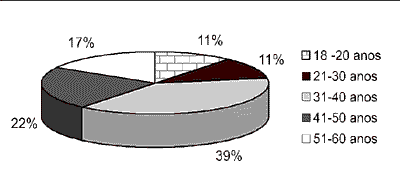 Graph 1.
Graph 1. Patients (n= 18) with peripheral Bell's palsy assessed for presence of hyperacusis in relation to age.
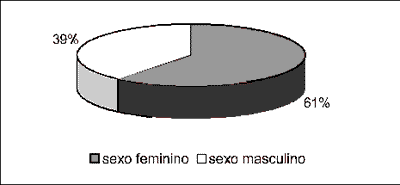 Graph 2.
Graph 2. Patients (n= 18) with peripheral Bell's palsy assessed for presence of hyperacusis in relation to gender.
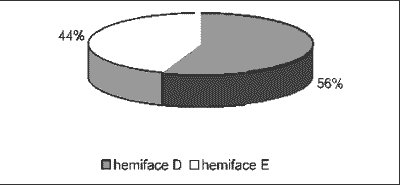 Graph 3.
Graph 3. Frequency of affected side in patients with peripheral facial palsy.
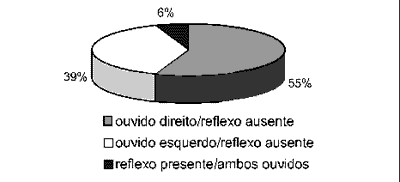 Graph 4:
Graph 4: Correlation between absence of stapedial reflex and patients with Bell's palsy.
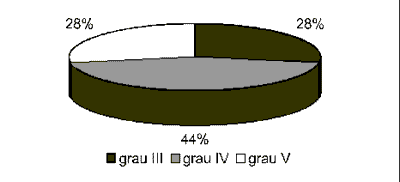 Graph 5.
Graph 5. Frequency of palsy grade * (1st visit), according to the classification by House.
 Graph 6.
Graph 6. Time of return of stapedial reflex after onset of peripheral facial palsy.
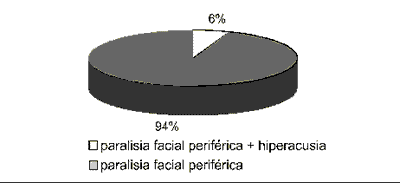 Graph 7.
Graph 7. Frequency of hyperacusis in patients with peripheral Bell's palsy.
Table 1. Loudness discomfort thresholds in affected and normal ears and the means (in frequencies of 500/1K/2K/4K).
